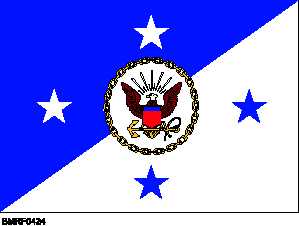conducted at the time of morning colors aboard ships
not under way, the ensign is hoisted to the top of the
flagstaff at the prescribed time. The church pennant is
then hoisted and the ensign dipped just clear of the
pennant. If the ensign is half-masted, the church
pennant is hoisted just above the ensign. When the
church pennant is lowered, the ensign is closed up
(hoisted to the truck, peak, or top of the flagstaff) before
the pennant is lowered. Although the church pennant
may not be flown above the national flag ashore, it may
be displayed separately.
The Jewish worship pennant, shown in figure 4-23,
is displayed during Jewish religious services afloat and
ashore. This pennant was authorized by the Secretary of
the Navy in 1975. The same rules governing the display
of the church pennant apply to the display of the Jewish
worship pennant.
The flag of the Chief of Naval Operations (fig. 4-24)
is a blue and white rectangle, divided diagonally from
lower hoist to upper fly. In its center is the official seal of
the Chief of Naval Operations—an eagle clutching an
anchor and encircled by 50 gold links of chain. The
CNO’s flag is displayed in the same manner as required
for displaying flags of any flag officer.
Aboard ships not under way, the absence (for a
period of 72 hours or less) of various officers is
indicated by the display of SUBSTITUTE pennants.
These are general signal pennants. The pennants are
assigned as shown in figure 4-25.
On many small ships, it is the responsibility of the
quarterdeck watch to hoist and haul down the absentee
pennants. They are flown only between sunrise and
sunset.
Whenever the ship is taking aboard, transferring, or
handling dangerous commodities, such as ammunition
and fuel, the BRAVO flag is hoisted and the smoking
lamp is put out. BRAVO is hauled down when the
dangerous condition no longer exists. The BRAVO flag
(fig. 4-26) is a general signal flag.
While standing watch, you will have many duties.
One of them is to make sure special flags or pennants are
displayed as required to indicate changing events
aboard ship. Usually on a large ship, this is the
responsibility of the duty signalman. On small ships,
such as submarines, it is the duty of the topside watch
(POOW). These flags or pennants are important
because they tell other units what is happening within
their area at any given time. A list of special flags and
pennants is normally posted within the quarterdeck area
for the ready reference of watch standers.
4-28
Student Notes:
Figure 4-25.—Substitute pennants.
Figure 4-26.—Bravo flag.
Figure 4-24.—Chief of Naval Operations flag.




